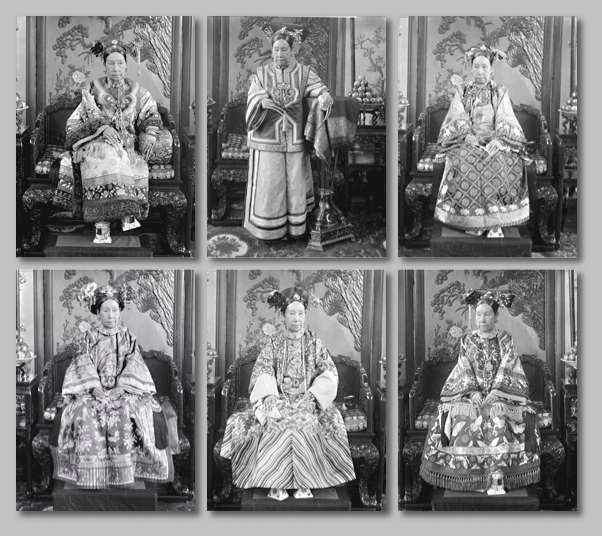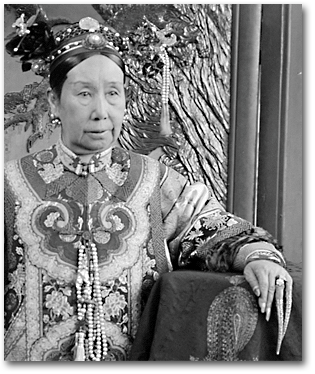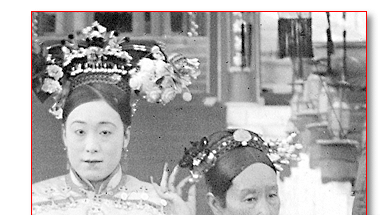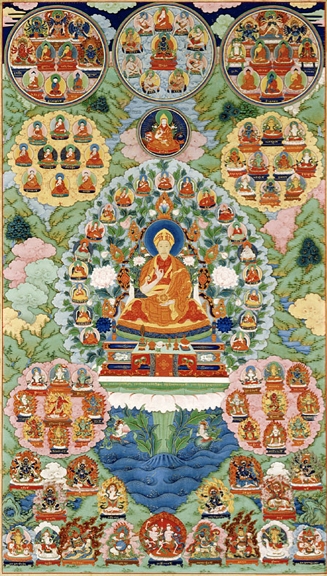| |
PIETY & POWER
Her Majesty said: "Let us go and have some more pictures taken while the weather is fine." So she walked the courtyard of the Audience Hall, where my brother had a camera ready, and had another photograph taken. She said that she would like to have some taken sitting on her throne, exactly as though she were holding an audience. It took us only a few minutes to have everything prepared in the courtyard. The screen was placed behind the throne, and her footstool was also placed ready for her, and she ordered one of the Court ladies to go and bring several gowns for her to select from. At the same time I went and brought some of her favorite jewelry. She ordered the two gowns which she had worn at the audiences when she received Admiral Evans and Mrs. Evans, to be brought in, and also the same jewels as she had worn on those respective occasions. She had two photographs taken in these costumes, one in each dress. [6]
Ten negatives of the Empress Dowager seated or standing alone before a throne comprise the largest subject group. Cixi presents herself in a variety of costumes, jewelry, and headdresses, but with a nearly uniform setting and furnishings. All were taken in the same makeshift outdoor studio in front of the Leshoutang in the New Summer Palace. At first glance, the portraits appear repetitious, but careful comparison suggests a richer variety of content. Some poses affect a state of regal authority, while others range from a Western-style casual contemplation to a theatricality that is jarringly coquettish.
|
|
| |
Regal Fashion
Cixi changed gowns and accessories frequently in this photo series posed with a throne in Xunling’s outdoor studio. Each costume is described in photographic
inventories, such as “Imperial Portraits in Dragon Robe and with Crown.” Cixi’s attention to appearance, ingrained from her days as as a young imperial concubine and heightened by her great love of theater, offers a contrast to the thoroughly predictable paintings of Qing court luminaries. This personal sense of fashion went hand in hand with her new appreciation of the power of photography in presenting a positive regal image to the outside world.
|
|

[cx104] [cx105] [cx102]
[cx107] [cx109] [cx108]
|
| |
In a book on the Palace Museum’s collection of Empress Dowager photographs, Lin Jing writes that Cixi had the photographs she liked enlarged, mounted in elaborate frames, and hung in her bedroom. “At that time, most of these photographs were hung in bedchamber on round-headed silver hooks shaped like flying dragons. Besides, a pair of hooks was used to support the bottom of the heavy frame.”
|
|
 |
Cixi rests her hand with its prominent, ornamented
fingernails on a Victorian-style pedestal.
[cx103]
|
 |
| |
The banner in the background of Cixi's portraits generally include her honorary
title as Grand Empress Dowager of the Qing Empire and, as typical of Qing imperial
rulers, included her lengthy accumulated titles describing her virtues.
detail [cx103]
|
|
 |
  “4-inch-long gold covers protect the third and little fingernails of her right hand and jade covers with the same length protect the third and little fingernails of her left hand.” “4-inch-long gold covers protect the third and little fingernails of her right hand and jade covers with the same length protect the third and little fingernails of her left hand.”
Lin Jing, The Photographs of Cixi in the Collection of the Palace Museum, page 30.
detail [cx103] |
| |
The seemingly coquettish poses Cixi sometimes assumed have long puzzled scholars, since they seem so out of character for a head of state—especially where she gazes into a hand mirror as she places a flower in her hair, rather in the manner of a young concubine. (See the opening photo in this unit.) The pose may have held particular meaning for her, since she repeats it several times.
It is possible that she is drawing from a scene in The Orchid Pavilion, one of her favorite popular operatic dramas—a theatrical reference that members of her court would immediately recognize. Regardless of origins, the striking individualism implicit in the pose reveals a willfulness exceptional for a woman so bound by convention and propriety.
|
|
 |
 A close-up detail in a formal outdoor group portrait of Cixi and her attendants unexpectedly reveals her using a small mirror to adjust her hair ornaments. A close-up detail in a formal outdoor group portrait of Cixi and her attendants unexpectedly reveals her using a small mirror to adjust her hair ornaments.
[cx124] full and detail |
|
| |
Venerable Old Buddha
Whenever I have been angry, or worried over anything, by dressing up as the Goddess of Mercy it helps me to calm myself, and so play the part I represent. I can assure you that it does help me a great deal, as it makes me remember that I am looked upon as being all-merciful. By having a photograph taken of myself dressed in this costume, I shall be able to see myself as I ought to be at all times. [7]
At the farther end of the performative nature of the photographs, Xunling shot two sets of religious tableaux in his studio in the New Summer Palace in which Cixi appears as Avalokitesvara, the androgynous bodhisattva (enlightened-being) who most deeply exemplified the Buddhist virtue of compassion. Predictably, these tableaux have provoked a range of critical responses.
|
|
 |
Cixi posing as the compassionate bodhisattva Avalokitesvara, with the high-ranking eunuchs Li Lien Ying and Tsue Yu Gay.
[cx128]
|
 |
  There were, in fact, many Qing imperial precedents for portraits identifying with a divinity, such as a well-known 18th-century painting of the Qianlong Emperor (1711–99) as Manjusri, a bodhisattva associated with transcendent wisdom. Rather than personal aggrandizement, the intent was to display imperial piety and spiritual aspiration. Cixi's role-playing as Avalokitesvara conveys a similar aspiration to integrate temporal and spiritual authority—a challenge all the more compelling given her status as a female head of state. There were, in fact, many Qing imperial precedents for portraits identifying with a divinity, such as a well-known 18th-century painting of the Qianlong Emperor (1711–99) as Manjusri, a bodhisattva associated with transcendent wisdom. Rather than personal aggrandizement, the intent was to display imperial piety and spiritual aspiration. Cixi's role-playing as Avalokitesvara conveys a similar aspiration to integrate temporal and spiritual authority—a challenge all the more compelling given her status as a female head of state. |
 |
  This painting of the Qianlong Emperor as the bodhisattva Manjusri illustrates Qing imperial precedents of identifying with Buddhist deities. This painting of the Qianlong Emperor as the bodhisattva Manjusri illustrates Qing imperial precedents of identifying with Buddhist deities.
[cx213] |
| |
At the same time, it is difficult to discount an element of whimsy in Cixi's religious tableaux. More than traditional Buddhism, the theatrical staging and props seem to reflect the strong influence of the Beijing Opera—an effect heightened by posing the court's leading eunuch officials as Cixi's divine attendants and costuming them in the familiar headdress of opera warriors.
|
|
| |
These two details show changes in personnel and costume
in this devotional construct.
details, top to bottom: [cx128] [cx129]
|
|
| |
A similar jumble of religious and secular theatricality characterizes Xunling's religious boating scenes as well. Here, in four of the photographer's most complex and panoramic compositions, Cixi is seated among her theatrically attired attendants on a flat boat, poled through an expanse of blooming lotuses outside
the
Forbidden
City. The lotus is a central symbol in Buddhism, and close scrutiny again reveals these scenes to be larded with Buddhist allusions.
|
|
| |
Cixi surrounded by eunuchs and courts ladies in a variety
of Buddhist and theatrical costumes.
[cx131]
|
|
| |
According to the archives of the Imperial Household Department, in 1903 the Empress Dowager issued the following directive to the Imperial Household Department for the photo shoot:
For the 16th day of the 7th month photo shoot on the Central Sea, prepare a boat that has no sail or roofing. Fourth daughter of Yikuang shall dress up as Sudhana (Child of Wealth) in a Lotus costume and a Wu- Beng. Li Lianying shall dress up as Skanda (Wei Tuo), perhaps with Skanda’s Helmet and related paraphernalia. Deling (San Gu Niang) and Rongling (Wu Gu Niang) shall play Punt Fairies. They shall have the fisherman’s bonnets and wear the costume dresses of Bai Suzhen, who is a white snake that has taken on human form. Perhaps they should also have some paraphernalia—either red or green would work. Have the Garden Department prepare two paddles for the junk, and have San Shun who works at the Imperial Household Department prepare several bamboo rods with leaves. All items must be ready for my inspection on the 8th day of the 7th month. [8] |
|
 |
| |
This detail from the above photograph shows Der Ling and Rong Ling costumed as “Punt Fairies” just as Cixi had instructed.
detail [cx131]
|
|
| |
In the existing negatives, various groupings and costume arrangements are tried, but Cixi is always the same, seated in front of the screen beneath the title “Putuoshan Guanyin,” a manifestation of the Bodhisattva Avalokitesvara. Putuoshan, an island off the coast of Zhejiang province, was considered one of the four sacred sites of Chinese Buddhism. Cixi was particularly devoted to this manifestation of the bodhisattva and had a priest from Putuoshan in court as spiritual advisor.
The sign on the screen identifies Cixi as a manifestation of the Bodhisattva of Compassion. Analysis of the high-resolution scans reveals additional textual markers. In addition to the requisite pyramid of fruit, a three-legged archaic bronze vessel is placed before the Empress Dowager, upon which is attached what appears to be a slip of paper with “Ningshougong” (Palace of Tranquil Longevity) written possibly in her own brush. Ningshougong was a complex built within the Forbidden City for the retirement of the Qianlong Emperor. Cixi particularly admired and emulated Qianlong, and his palace was given over for her use. An identical sign is attached to an enameled porcelain vase at the far end of the boat. |
|
| |
Texts displayed in the boat scene include a three-legged bronze vessel with a slip of paper with “Ningshougong” (Palace of Tranquil Longevity) written on it and an identical sign attached to a porcelain vase. The sign on the screen identifies Cixi as a manifestation of the Bodhisattva of Compassion.
Details from above image of Cixi on a boat [cx131]
[cx244] [cx245] [cx246] |
|
| |
Rising out of the bronze vessel is a striking object in the shape of the character for longevity stylized into a wisp of smoke. It is unclear what this object is constructed from, but textiles and other decorative arts in Cixi’s court were notable for boldly displayed longevity symbols. In the high-resolution scans one can make out three previously unreadable characters on the top of the longevity character. The characters read Guangrenzi, or “Broad Benevolence,” which was Cixi’s Daoist title, conferred by the abbot of Baiyunguan, a major Daoist temple in Beijing and a political base for the court’s conservative faction.
Thus decorative elements take on considerable significance and, in combination with the Putuoshan Guanyin screen and the reference to Qianlong’s palace, indicate that the boating scene is more than a picnic with eunuchs and attendants in opera costumes. On the contrary, Cixi was employing photography to create a calculated assemblage of intersecting references to religious and political alliances, associations, and hierarchies, as she sought to maintain her own political legitimacy within the factional environment of the final years of Qing dynastic decline.
|
|
| |

|
|
|





